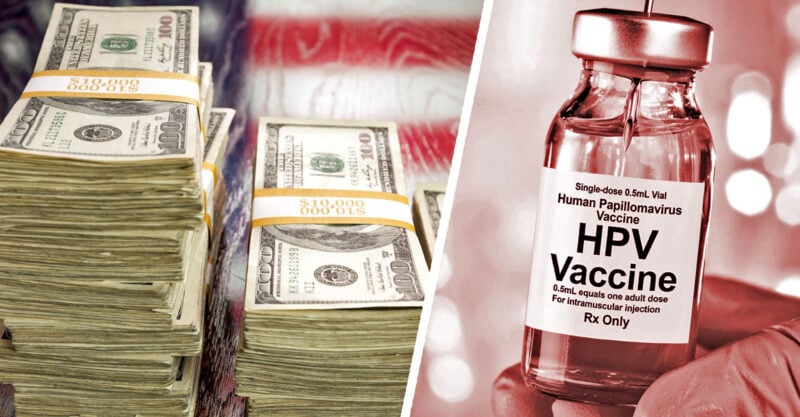Miss a day, miss a lot. Subscribe to The Defender's Top News of the Day. It's free.
Editor’s note: This is the second in a two-part series examining federal funding for behavior modification approaches to increase uptake among teens of the human papillomavirus vaccine. Read part 1 here.
Researchers at the University of North Carolina, Chapel Hill (UNC) are testing whether financial incentives work to “nudge” physicians to switch up their approach to recommending the human papillomavirus (HPV) vaccine for adolescents in order to increase vaccine uptake, according to documents obtained by Children’s Health Defense via a Freedom of Information Act request.
Using a $4.7 million grant from the National Cancer Institute (NCI) at the National Institutes of Health (NIH), a research team led by Merck consultant and UNC health behavior professor Noel Brewer, Ph.D., is conducting four studies to determine the best ways to get providers and clinics to consistently use Brewer’s “Announcement Approach” to vaccine communication.
Using the “Announcement Approach,” providers skip the step of discussing with families in “open-ended conversation” whether or not they want their child vaccinated for HPV and instead “presume” the family wants the vaccine and announce the child will receive it as if it were a routine part of the office visit.
Previous research has shown this method reduces the time a provider needs to spend talking with their patients and increases vaccine uptake, although it also decreases patient satisfaction with the clinical experience in observational studies.
The different research projects in Brewer’s study train providers in the Announcement Approach and then test different forms of what behavioral economists call “nudging” — moving people toward desired choices by changing the “choice architecture” they are operating in — to see what works better to get them to implement it regularly.
In one of the four studies funded by the grant, Justin Trogdon, Ph.D., a health economist at UNC who also received Merck funding for vaccine uptake research, will lead a team investigating the impacts of financial incentives to clinics on HPV uptake.
According to the grant, financial incentives or “Pay for Performance” to nudge physicians to prescribe particular interventions are increasingly common in healthcare.
The HPV vaccine is an ideal candidate for financial incentives because its outcomes are simple, easy to track and there is significant room for “improvement.”
Currently, about 54% of teens complete the series, according to the proposal. The Centers for Disease Control and Prevention’s “healthy people” target is 80%.
According to the proposal, research shows that financial incentives work to change provider behavior. It also shows that financial nudges work best when people are threatened with losses, not only with financial gain.
This is one of the few studies to integrate a “loss aversion” strategy into a provider incentive program, it says.
Nudging doctors with money and shame
The study offers financial incentives at the clinic level to clinics whose doctors implement the Announcement Approach to increase HPV uptake.
It also provides regular, public feedback meant to cause the loss of “social esteem” to doctors who are failing to increase HPV vaccine uptake, testing providers’ impulses toward loss aversion and the effects of social comparison.
“Loss aversion is where more effort is made to avoid losses than to achieve a similarly-sized gain,” the proposal says. It takes advantage of people’s natural proclivity for social comparison to incentivize behaviors using “positive” peer pressure.
All clinics participating in the study receive $2,000 to participate. Investigators assess the baseline rates of HPV vaccination uptake among the clinic’s patients, and providers receive a one-hour Announcement Approach Training (AAT).
The control group of clinics receives no further financial incentive.
The clinics that receive financial incentives are awarded $1,000 per provider if they get HPV uptake at the clinic level among children and teens to the 80% “healthy people” goal. The payments are aggregated and go to the clinic.
Clinics that don’t meet the 80% goal get smaller bonuses for increasing HPV vaccine uptake rates relative to baseline.
The payment structure is set up to motivate the clinics’ impulse toward financial loss aversion. The payments are made to the clinics up front, and deposited in a study-held account, presuming they will hit the 80% target.
But if they don’t meet the targets, the money will be withdrawn from the account. The account balance will be included in the monthly reports.
In preliminary interviews, providers told investigators they thought financial incentives would work to increase HPV uptake, based on their experience with other interventions they receive financial incentives for, according to the proposal.
One provider told investigators, “If HPV vaccine became a quality metric with a financial incentive connected to it, then you would see rates go up very quickly.”
The study involves 1,500 providers (physicians, physician assistants and nurse practitioners) and 1,000 nurses and medical assistants at clinics in North Carolina.
“Peer comparison feedback, in which providers’ performance is ranked amongst other providers in the clinic, motivates improved performance by engaging professional pride, a desire for social esteem, and establishing social norms,” the proposal says.
To leverage providers’ pride and desire for social esteem — or their anxiety about losing it — providers’ HPV vaccination rates will be reported monthly to the entire clinic.
Providers will be ranked relative to other providers in their clinic as to how well they are doing increasing HPV vaccine uptake and will be given overall clinic rates along with how the clinic is doing overall “improving” uptake relative to baseline.
All providers will receive this information in a monthly email and they will be discussed publicly at a monthly in-person staff meeting. Investigators will also measure engagement with the report website to see how often the providers are checking the feedback.
Outcomes: increased HPV vaccine uptake
To measure the outcomes of this year-long study, the investigators obtain the HPV vaccination rates before, during, and after the study period by searching electronic health records of children ages 9-17 in the clinics. In doing so, the study is also creating a tool to monitor HPV vaccination rates, it says.
The primary outcome measured by the study is the number of 13-year-old children who get “up-to-date” with the recommended HPV vaccinations.
Secondary outcomes include whether younger children initiated or completed the course of vaccines and whether older children who were not previously up to date began or completed vaccination.
The investigators are also examining changing attitudes and practices of the providers, nurses and medical assistants. They hypothesize that the AAT training and financial incentives and peer pressure will lead providers to think that HPV vaccination is more important, increase their intention to “make sure all patients get an HPV recommendation before they turn 13,” create new clinic norms around HPV recommendations, and use the Announcement Approach.
They also plan to use the outcomes to refine the implementation of AAT and to assess the costs of getting more adolescents to initiate the HPV vaccine series.
No informed consent for children, families participating in study
Participants in research involving human subjects must be informed they are in a research study and provide their consent. The U.S. Department of Health and Human Services, the parent organization of grant sponsor NCI/NIH has set regulations for the protection of human subjects in research in the code of federal regulations, 45 CFR 46.
Under that code, the Common Rule establishes “human subjects” as living individuals about whom an investigator is conducting research.
The research includes taking specimens, applying interventions — including “manipulations of the subject or the subject’s environment” — interacting with subjects, collecting private information in situations where the subject would not expect recording to be taking place, or collecting identifiable information.
The outcomes of the study are clearly stated as increased uptake of the HPV vaccine among children and adolescents, and the study seeks to change how providers interact with their patients (the subject’s environment) and the data analyzed will come from the Electronic Health Records of patients aged 9-17 before, during and after the intervention, not retrospectively.
But The Defender found that in this case only the providers — not the children or the families — are asked to provide informed consent.
Human subjects research requires that researchers explain why the people in the study are appropriate subjects for addressing the research question at hand, which includes justifying the age of the study participants.
The proposal states that because the surveys and interventions focus on primary care professionals “only adults working in their professional roles in pediatric primary care will be included in the studies,” and it says “We will not interact with children as part of the trial,” thus eliminating children as “research subjects.”
But, James Lyons-Weiler, Ph.D., of the Institute for Pure and Applied Knowledge and IPAK-EDU told The Defender that given the study measures changes in vaccine uptake among children and adolescents, not informing families and children they are involved in a research study raises serious issues of informed consent.
He said:
“This is a non-randomized prospective clinical trial, and it is not being handled properly regarding informed consent. Any study involving human subjects that leads to a change in the interventions involving prophylaxis or treatment requires annual IRB [Institutional Review Board] oversight and direct informed consent for adults or informed permission for minors.
“While this study seeks to change physician behavior in their interactions with patients, it is designed to implement a change in the nature of the private interactions between family and physician, with the expected outcome being increased uptake of a medical intervention. That makes this a clinical trial.”
But only providers need to sign informed consent forms and provide verbal consent at different points in the study when they are assessed.
The proposal also states, “We anticipate that risks to participants will be minimal and manageable.”
Since Gardasil — the only HPV vaccine available in the U.S. market — was introduced in 2006, numerous studies have linked it to debilitating autoimmune disorders, neurological side effects and other complications, prompting many families of injured children to file lawsuits alleging the company knew the vaccine could cause serious side effects.
Until the COVID-19 vaccine became available, the FDA had received more adverse reaction reports related to Gardasil than any other vaccine in history.
The National Vaccine Injury Compensation Program has paid out over $70 million to people making claims regarding Gardasil. Merck now faces more than 80 complaints in federal court alleging that the HPV vaccine caused debilitating autoimmune complications. A judge consolidated 31 of these cases into a single bellwether pool, against Merck’s protest.





